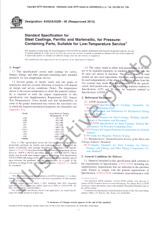We need your consent to use the individual data so that you can see information about your interests, among other things. Click "OK" to give your consent.
ASTM D7871-23
Standard Test Method for Analysis of Cyclohexane by Gas Chromatography (Effective Carbon Number)
Translate name
STANDARD published on 1.4.2023
The information about the standard:
Designation standards: ASTM D7871-23
Publication date standards: 1.4.2023
SKU: NS-1138649
The number of pages: 7
Approximate weight : 21 g (0.05 lbs)
Country: American technical standard
Category: Technical standards ASTM
The category - similar standards:
Annotation of standard text ASTM D7871-23 :
Keywords:
analysis by gas chromatography, benzene, cyclohexane,, ICS Number Code 71.080.10 (Aliphatic hydrocarbons)
Additional information
| Significance and Use | ||||||||||||||||
|
5.1?This test method is suitable for setting specifications on the materials referenced in Table 1 and for use as an internal quality control tool where cyclohexane is produced or is used in a manufacturing process. It may also be used in development or research work involving cyclohexane. 5.2?This test method is useful in determining the purity of cyclohexane with normal impurities present. If extremely high boiling or unusual impurities are present in the cyclohexane, this test method would not necessarily detect them and the purity calculation would be erroneous. |
||||||||||||||||
| 1. Scope | ||||||||||||||||
|
1.1?This test method covers the determination of the purity of cyclohexane by gas chromatography. 1.2?This test method has been found applicable to the measurement of impurities such as those found in Table 1, which are impurities that may be found in cyclohexane. The impurities can be analyzed over a range with an upper limit of 400 mg/kg by this method, but may be applicable to a wider range. The limit of detection (LOD) is 0.7 mg/kg and the limit of quantitation (LOQ) is 2.3 mg/kg. Note 1:?The LOD and LOQ were calculated from the ILS data for
benzene.
1.3?The following applies for the purposes of determining the conformance of the test results using this test method to applicable specifications: results shall be rounded off in accordance with the rounding-off method of Practice E29. 1.4?The values stated in SI units are to be regarded as standard. No other units of measurement are included in this standard. 1.5?This standard does not purport to address all of the safety concerns, if any, associated with its use. It is the responsibility of the user of this standard to establish appropriate safety, health, and environmental practices and determine the applicability of regulatory limitations prior to use. 1.6?This international standard was developed in accordance with internationally recognized principles on standardization established in the Decision on Principles for the Development of International Standards, Guides and Recommendations issued by the World Trade Organization Technical Barriers to Trade (TBT) Committee. |
||||||||||||||||
| 2. Referenced Documents | ||||||||||||||||
|
We recommend:
Technical standards updating
Do you want to make sure you use only the valid technical standards?
We can offer you a solution which will provide you a monthly overview concerning the updating of standards which you use.
Would you like to know more? Look at this page.




 Cookies
Cookies
